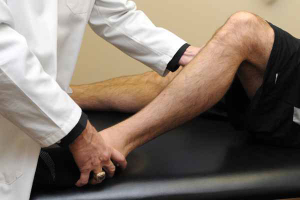The posterolateral drawer test is important for assessing the integrity of the popliteus components of the knee. The starting point for this test is similar to the posterior drawer test, but the foot is externally rotated about 15°. With this test a coupled posterior force and external rotation torque is applied to the tibia to determine the amount of rotation of the tibial tubercle that occurs compared tp the distal femur. This test is unique for each patient and it is important to compare to the contralateral side to see the amount of increased external rotation that occurs. A positive posterolateral drawer test is usually indicative of a grade III posterolateral corner injury with injuries to the popliteofibular ligament and popliteus tendon.
About the Author: Robert LaPrade, MD
Robert LaPrade, MD, PhD has specialized skills and expertise in diagnosing and treating complicated knee injuries. He has treated athletes at all levels, including Olympic, professional and intercollegiate athletes, and has returned numerous athletes back to full participation after surgeries. Recognized globally for his outstanding and efficient surgical skills and dedication to sports medicine, he has received many research awards, including the OREF Clinic Research Award considered by many a Nobel Prize in orthopedics. Dr. LaPrade is one of the most published investigators in his field, and many of the surgeries that he has developed are now performed worldwide and recognized as the “gold standard” for the treatment of complex knee injuries.

